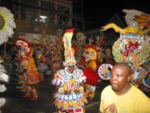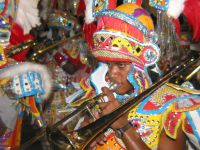Music of the Bahamas
2007 Schools Wikipedia Selection. Related subjects: Musical genres, styles, eras and events
| Anglophone caribbean music | |||||||||||||
|---|---|---|---|---|---|---|---|---|---|---|---|---|---|
|
|||||||||||||
| Timeline and Samples | |||||||||||||
| Pop genres | Calypso - Chutney - Dancehall - Dub - Junkanoo - Ragga - Rapso - Reggae - Ripsaw - Rocksteady - Scratch - Ska - Soca - Spouge - Steelpan | ||||||||||||
| Other islands | |||||||||||||
| Aruba and the Dutch Antilles - Cuba - Dominica - Dominican Republic - Haiti - Martinique and Guadeloupe - Puerto Rico - Saint Lucia | |||||||||||||
The music of the Bahamas is associated primarily with junkanoo, a celebration which occurs on Boxing Day ( December 26) and again on New Year's Day ( January 1). Parades and other celebrations mark the ceremony. Groups like The Baha Men, Ronnie Butler and Kirkland Bodie have gained massive popularity in Japan, the United States and elsewhere.
Junkanoo
The word junkanoo is said to be derived from a Ghanaian leader, John Connu, or from the Qujo supreme deity ( Canno) and ancestral spirits ( jannanin). The junkanoo was formerly practiced in North Carolina and remnants still exist in Belize, Jamaica and, most commonly, Bermuda. Its capital, though, |Nassau]], and Freeport and the Family Islands. Bahamian music has been declining throughout the 20th century, partially due to the influence of American culture and the proximity of TV and radio stations in Florida (which can be picked up in the Bahamas) as well as the arrival of musical forms like calypso, reggae and soca from Jamaica, Cuba and Trinidad, among other Caribbean islands. Tourism has also had an impact, bringing in Japanese, European and North Americans with their attendant forms of cultural expression. In spite of this, Bahamian performers like Joseph Spence have become underground stars playing junkanoo, Christian hymns and the ant'ems of the local sponge fisherman, which include "Sloop John B", later made famous by The Beach Boys.
Junkanoo's origins are obscure and much-debated. Researchers like E. Clement Bethel have studied the issue extensively, and likely conclusions include that African slaves were allowed celebrations only around Christmas-time, and chose to celebrate John Connu, a headman from 18th century Africa. Another theory is that the term derives from scrap metal or other objects (junk) used to create the distinctive goombay drum. Similar celebrations once existed cross the Caribbean and in North Carolina, but are now virtually extinct except in the Bahamas and Belize.
With the 1973 independence from the United Kingdom, black professionals of the middle- and upper-classes began to dominate junkanoo celebrations. Costuming and competitions became more complex and commonplace, and soon became a tourist draw.
Aside from being a type of drum, goombay is also a percussion music made famous by Alphonso 'Blind Blake' Higgs, who played to tourists arriving at Nassau International Airport for several years. Rake-and-scrape music is a unique type of instrumental music made by bending a saw and scraping with a small object, most typically a screwdriver; it is used to accompany dances derived from European forms like polka and waltz. Rake-and-scrape's popularity has been declining in recent years, but performers like Lassie Do and the Boys continue to keep the tradition alive. Christian rhyming spirituals and the ant'ems of sponge fisherman are now mostly dead traditions, decimated by the arrival of pop music, a 1930s sponge blight and other causes.
E. Clement Bethel's master's thesis on traditional Bahamian music was adapted for the stage by his daughter, Nicolette Bethel and Philip A. Burrows. Music of The Bahamas was first performed at the Edinburgh Festival Fringe in 1991, and was revived in 2002 for fresh Bahamian audiences. A recording of that show is available for sale from Ringplay Productions.
Ripsaw
Ripsaw music comes from the musical traditions of the Turks and Caicos Islands, and is characterized by the use of a saw as the primary instrument. It was brought by immigrants from those islands from the 1920s to about the 1940s, who settled on Cat Island, and elsewhere. Many of these Turks and Caicos Islanders became some of the most famous musicians in the Bahamas. Many eventually moved back to their homelands, bringing with them junkanoo. Turks and Caicos are now the second home for junkanoo.
Other
- List of Bahamian musicians

